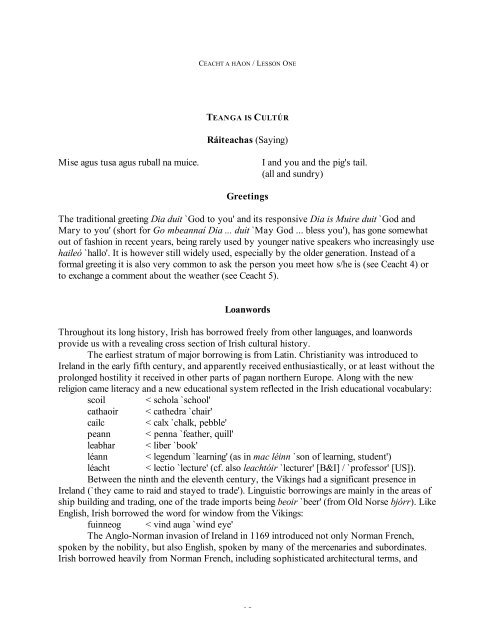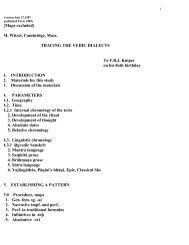Buntús na Gaeilge - People Fas Harvard - Harvard University
Buntús na Gaeilge - People Fas Harvard - Harvard University
Buntús na Gaeilge - People Fas Harvard - Harvard University
You also want an ePaper? Increase the reach of your titles
YUMPU automatically turns print PDFs into web optimized ePapers that Google loves.
CEACHT A HAON / LESSON ONE<br />
TEANGA IS CULTÚR<br />
Ráiteachas (Saying)<br />
Mise agus tusa agus ruball <strong>na</strong> muice. I and you and the pig's tail.<br />
(all and sundry)<br />
Greetings<br />
The traditio<strong>na</strong>l greeting Dia duit `God to you' and its responsive Dia is Muire duit `God and<br />
Mary to you' (short for Go mbean<strong>na</strong>í Dia ... duit `May God ... bless you'), has gone somewhat<br />
out of fashion in recent years, being rarely used by younger <strong>na</strong>tive speakers who increasingly use<br />
haileó `hallo'. It is however still widely used, especially by the older generation. Instead of a<br />
formal greeting it is also very common to ask the person you meet how s/he is (see Ceacht 4) or<br />
to exchange a comment about the weather (see Ceacht 5).<br />
Loanwords<br />
Throughout its long history, Irish has borrowed freely from other languages, and loanwords<br />
provide us with a revealing cross section of Irish cultural history.<br />
The earliest stratum of major borrowing is from Latin. Christianity was introduced to<br />
Ireland in the early fifth century, and apparently received enthusiastically, or at least without the<br />
prolonged hostility it received in other parts of pagan northern Europe. Along with the new<br />
religion came literacy and a new educatio<strong>na</strong>l system reflected in the Irish educatio<strong>na</strong>l vocabulary:<br />
scoil < schola `school'<br />
cathaoir < cathedra `chair'<br />
cailc < calx `chalk, pebble'<br />
peann < pen<strong>na</strong> `feather, quill'<br />
leabhar < liber `book'<br />
léann < legendum `learning' (as in mac léinn `son of learning, student')<br />
léacht < lectio `lecture' (cf. also leachtóir `lecturer' [B&I] / `professor' [US]).<br />
Between the ninth and the eleventh century, the Vikings had a significant presence in<br />
Ireland (`they came to raid and stayed to trade'). Linguistic borrowings are mainly in the areas of<br />
ship building and trading, one of the trade imports being beoir `beer' (from Old Norse bjórr). Like<br />
English, Irish borrowed the word for window from the Vikings:<br />
fuinneog < vind auga `wind eye'<br />
The Anglo-Norman invasion of Ireland in 1169 introduced not only Norman French,<br />
spoken by the nobility, but also English, spoken by many of the merce<strong>na</strong>ries and subordi<strong>na</strong>tes.<br />
Irish borrowed heavily from Norman French, including sophisticated architectural terms, and<br />
10

















